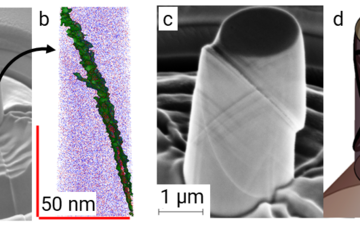All genres
101.
Journal Article
Exploring the Surface Segregation of Rh Dopants in PtNi Nanoparticles through Atom Probe Tomography Analysis. The Journal of Physical Chemistry C 127 (46), pp. 22721 - 22725 (2023)
102.
Journal Article
Introducing field evaporation energy loss spectroscopy. Communications Physics 6, 100 (2023)
103.
Journal Article
Near-Atomic-Scale Evolution of the Surface Chemistry in Li[Ni,Mn,Co]O2 Cathode for Li-Ion Batteries Stored in Air. Advanced Energy and Sustainability Research 4 (1), 2200121 (2023)
104.
Journal Article
Facilitating the Systematic Nanoscale Study of Battery Materials by Atom Probe Tomography through in-situ Metal Coating. Batteries & Supercaps 7 (2), e202300403 (2023)
105.
Journal Article
Scalable substrate development for aqueous sample preparation for atom probe tomography. Journal of Microscopy (2023)
106.
Journal Article
Effect of Pore Formation on Redox-Driven Phase Transformation. Physical Review Letters 130, 168001 (2023)
107.
Journal Article
Phase separation and anomalous shape transformation in frozen microscale eutectic indium-gallium upon remelting. Materialia 26, 101595 (2022)
108.
Journal Article
Hydriding of titanium: Recent trends and perspectives in advanced characterization and multiscale modeling. Current Opinion in Solid State and Materials Science 26, 101020 (2022)
109.
Journal Article
A comparative study of Nd15Fe78B7 and Nd15Co78B7 systems: phase formations and coercivity mechanisms. Acta Materialia 240, 118311 (2022)
110.
Journal Article
The effect of γ matrix channel width on the compositional evolution in a multi-component nickel-based superalloy. Scripta Materialia 219, 114853 (2022)
111.
Journal Article
Suppressed hydrogen embrittlement of high-strength Al alloys by Mn-rich intermetallic compound particles. Acta Materialia 236, 118110 (2022)
112.
Journal Article
Fe30Co40Mn15Al15: A Novel Single-Phase B2 Multi-Principal Component Alloy Soft Magnet. High Entropy Alloys & Materials 1, pp. 96 - 109 (2022)
113.
Journal Article
Correlating atom probe tomography with x-ray and electron spectroscopies to understand microstructure-activity relationships in electrocatalysts. MRS Bulletin 47, pp. 718 - 726 (2022)
114.
Journal Article
Hydride Formation and Deformation Mechanisms in Commercially Pure Titanium. Microscopy and Microanalysis 28 (S1), pp. 1634 - 1636 (2022)
115.
Journal Article
Bubbles and atom clusters in rock melts: A chicken and egg problem. Journal of Volcanology and Geothermal Research 428, 107574 (2022)
116.
Journal Article
Reflections on the Spatial Performance of Atom Probe Tomography in the Analysis of Atomic Neighborhoods. Microscopy and Microanalysis 28 (4), pp. 1116 - 1126 (2022)
117.
Journal Article
Preliminary Atom Probe Tomography Evidence for Hydrogen Trapping at a β-Nb Second Phase Particle in a Neutron-irradiated Zirconium Alloy. Microscopy and Microanalysis 28 (S1), pp. 1658 - 1659 (2022)
118.
Journal Article
Hydrogen/Deuterium Charging Methods for the Investigation of Site-Specific Microstructural Features by Atom Probe Tomography. Microscopy and Microanalysis 28 (S1), p. 1664 (2022)
119.
Journal Article
A Liquid Metal Encapsulation for Analyzing Porous Nanomaterials by Atom Probe Tomography. Microscopy and Microanalysis 28 (4), pp. 1198 - 1206 (2022)
120.
Journal Article
Mysterious Field Evaporation Behavior of Hydrogen in Aluminium Based Material Analyzed with Atom Probe Tomography. Microscopy and Microanalysis 28 (S1), pp. 690 - 691 (2022)











